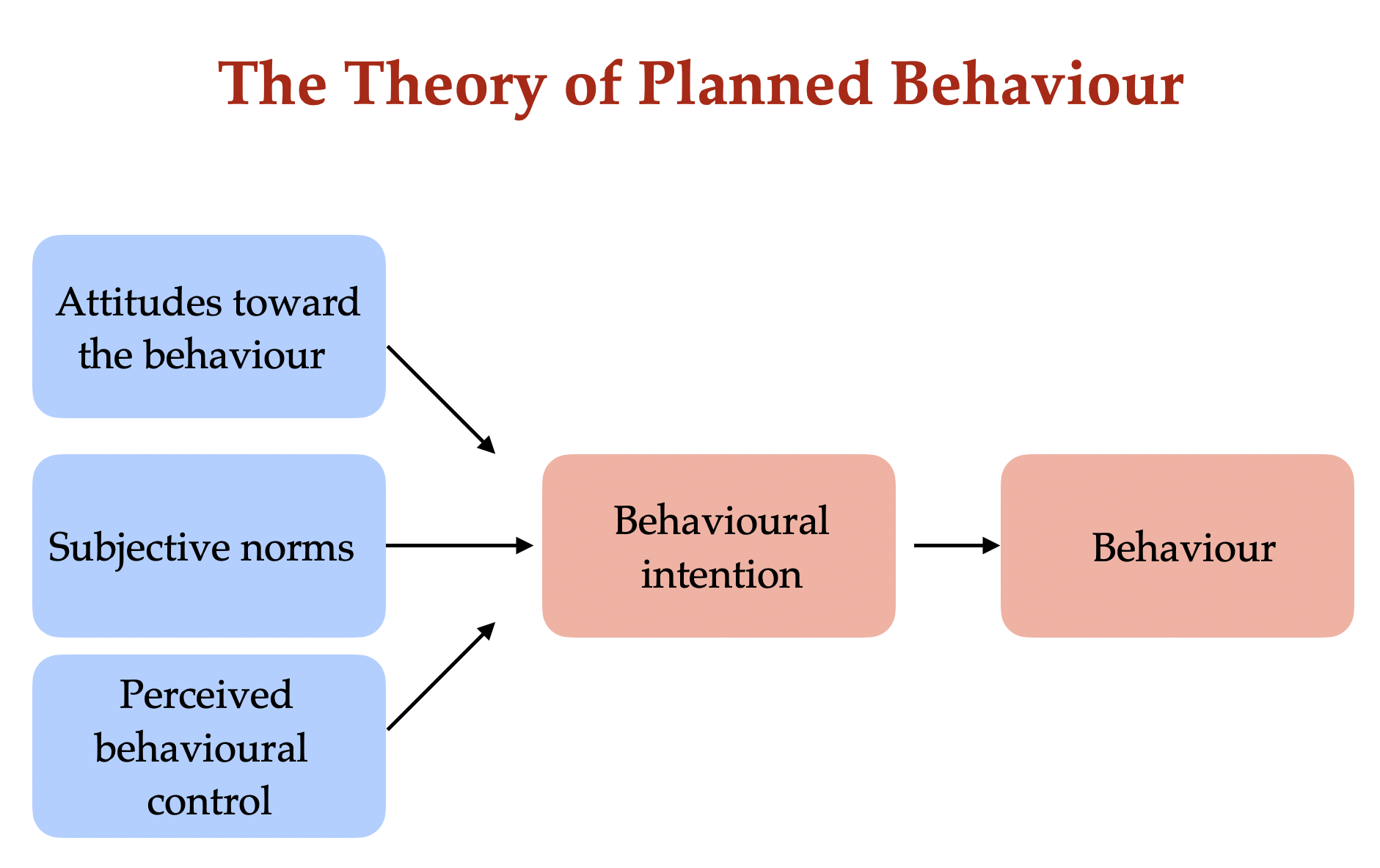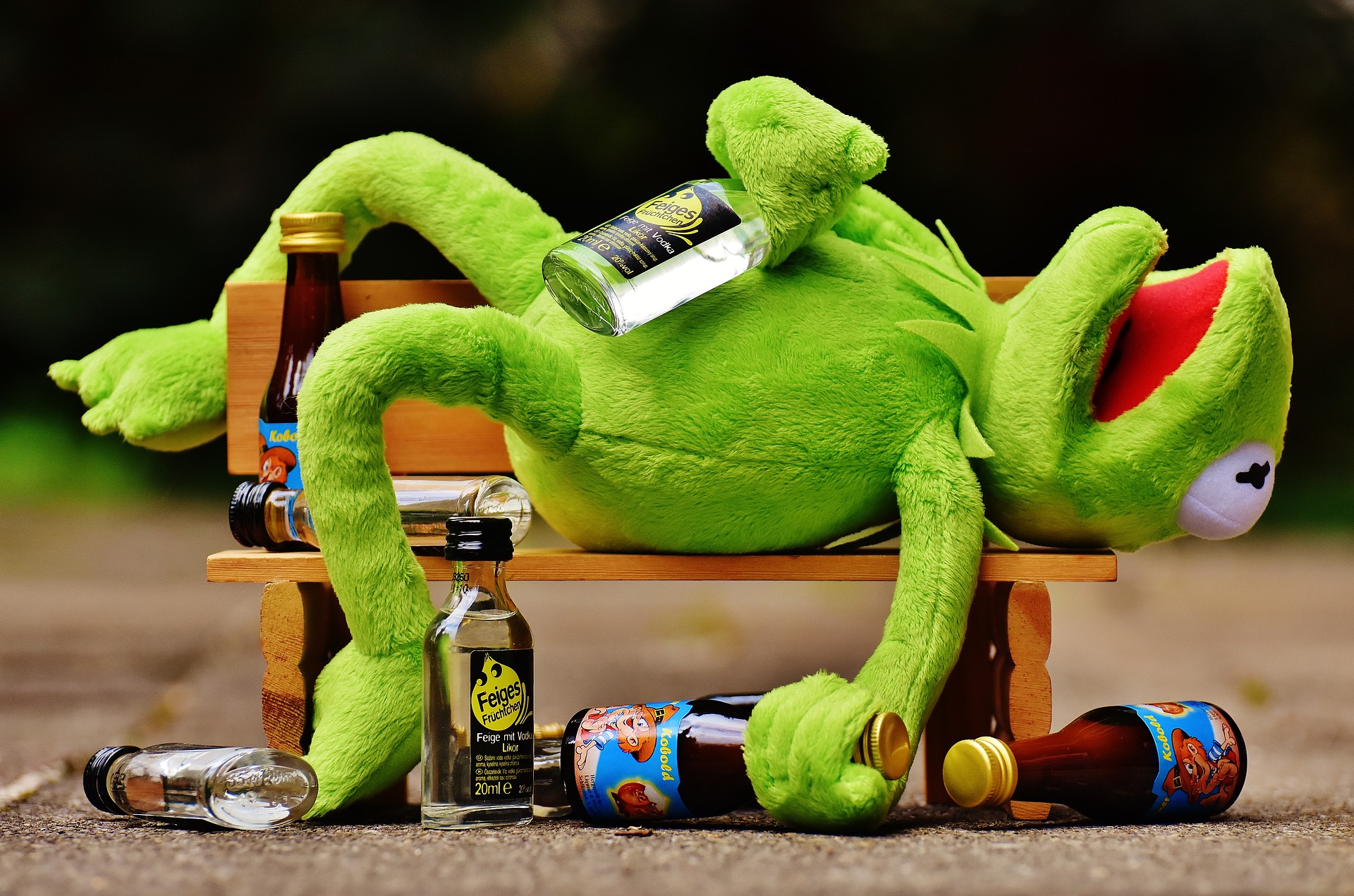Cognitive explanations of addiction
 Cognitive psychologists are interested in how the way we think influences the way we behave. In research on addiction and substance abuse, a lot of the research is on why individuals decide to start using a drug - and how they are able to quit.
Cognitive psychologists are interested in how the way we think influences the way we behave. In research on addiction and substance abuse, a lot of the research is on why individuals decide to start using a drug - and how they are able to quit.
One of the key thinking models that is used to study addiction and drug-related behaviours is the Theory of Planned Behaviour. Another theory is the self-determination theory. These two theories are the basis for our discussion of the role of thinking and decision making in addiction.
The Theory of Planned Behaviour
The following video explains the three key components of the theory of planned behaviour.
The theory can thus be summarized with the following diagram.

In other words, if I think that the behaviour is positive and relevant, that others think the same, and that I have the ability to actually manage the behaviour, then I will make a conscious decision to carry out the behaviour. This theory has been applied to substance use and abuse and may help us to understand behaviour that leads to addiction.
Research in psychology: Johnston and White (2003)
 Johnson and White (2003) wanted to test the effectiveness of the Theory of Planned Behaviour [TPB] in predicting binge drinking behaviour. The sample was comprised of 223 Australian undergraduate students, with a mean age of 26. The study was a prospective study carried out over a two-week period. At the start of the testing period, participants filled in a series of questionnaires. The questionnaires measured the three aspects of the Theory of Planned Behaviour. The participants were asked to answer the questions using a 7-point Likert scale, with responses ranging from "extremely unlikely" to "extremely likely."
Johnson and White (2003) wanted to test the effectiveness of the Theory of Planned Behaviour [TPB] in predicting binge drinking behaviour. The sample was comprised of 223 Australian undergraduate students, with a mean age of 26. The study was a prospective study carried out over a two-week period. At the start of the testing period, participants filled in a series of questionnaires. The questionnaires measured the three aspects of the Theory of Planned Behaviour. The participants were asked to answer the questions using a 7-point Likert scale, with responses ranging from "extremely unlikely" to "extremely likely."
Samples of questions include:
- I find drinking five or more standard alcoholic drinks in a single session acceptable. (Attitude)
- If I drink five or more standard alcoholic drinks in a single session, most people who are important to me would find that acceptable. (Subjective norms)
- If I wanted to, it would be easy for me to drink five or more standard alcoholic drinks in a single session. (Behavioural control)
- I intend to drink five or more standard alcoholic drinks in a single session in the next two weeks. (Intention)
The researchers then had the participants return after two weeks and asked whether they had consumed five or more standard alcoholic drinks in a single session in the last two weeks.
The findings indicated that 38% of participants had engaged in binge drinking over the two week period and that the components of the TPB accounted for 69% of the variance in the participants' behaviour. Attitude, social norms, and intention all played a significant role - but self-efficacy (perceptual control) did not.
The study by Johnston and White (2003) demonstrates one of the consistent criticisms of the theory - that is, that not all three of the key components play a role in behaviour. In a similar study, carried out by Collins and Carey (2007), they found that binge drinking was linked to attitude and behavioural control, but not to subjective norms. But this difference may be easily explained. In Johnston and White's study, the questions were about one's sense of self-efficacy with regard to drinking - do you think you can do it? Whereas, in the study by Collins and Carey (2007), they focused on what they called "refusal-efficacy" - that is, the ability to refuse another drink. It could be that the types of questions that are asked when carrying out research on the effectiveness of the TPB may play a key role in the results.
Silva et al (2013) carried out a study of 32 young Portuguese participants to apply the TPB on their wine consumption. The study included both a questionnaire that asked questions similar to those in other studies of TPB and then carried out focus groups in which they were asked questions about norms, attitudes, and intentions. The researchers found that attitudes and perceived norms played an important role in wine consumption. Those who drank wine the most regularly were those who felt that wine is associated with special occasions and was part of being social. Non-consumers felt that their parents did not approve of drinking.
ATL: Critical thinking - The role of innovation
 Sometimes when there is something new on the market, behaviours change. A recent study looked at the ability of TPB in predicting university students' use of e-cigarettes. Trumbo and Harper (2013) asked 244 first and second-year university students to complete an online survey about their attitudes toward e-cigarettes, their thoughts on public acceptance of the behaviour and their potential intention of smoking them. They found that the students' attitudes and perception of social norms significantly predicted their behaviour.
Sometimes when there is something new on the market, behaviours change. A recent study looked at the ability of TPB in predicting university students' use of e-cigarettes. Trumbo and Harper (2013) asked 244 first and second-year university students to complete an online survey about their attitudes toward e-cigarettes, their thoughts on public acceptance of the behaviour and their potential intention of smoking them. They found that the students' attitudes and perception of social norms significantly predicted their behaviour.
Why would e-cigarettes result in some non-smokers potentially starting to smoke? How does the TPB explain this change in behaviour? What does this say about innovation in the marketplace?
Why would e-cigarettes result in some non-smokers potentially starting to smoke?
People like to try out the newest trend - and since it was seen as "safe", or at least "safer" than regular cigarette smoking, people were willing to try it. They were also seen as "cleaner" and lacked the smell of cigarette smoke, which many people link to the negative health benefits. Finally, as it was a new trend, there were high levels of peer pressure within certain groups to try it.
How does the TPB explain this change in behaviour?
A big change in modern society is the negative attitude toward cigarette smoking. So, subjective norms and personal attitudes toward the behaviour were generally not supportive of smoking. However, e-cigarettes were seen as the "healthy alternative." People not only did not have negative associations with e-smoking, but there was a positive community attitude towards it - that is, a positive subjective norm. Finally, the promotion of e-smoking was that it was safe(r). This may have given people a sense of control over their habits and that they would be able to stop at any time.
What does this say about innovation in the marketplace?
This shows that challenging subjective norms by changing the presentation and promotion of a product can increase its use.
The theory has high predictive validity in various areas of health psychology - including condom use, exercise, and diet. However, the efficiency of the theory varies between health-related behavior categories.
On the one hand, the theory is holistic, taking into account both cognitive processes and social norms. On the other hand, the theory focuses too much on cognitive processes and does not address the role of emotion or the biological effects of the drugs themselves.
The theory does not address the question of internal vs external motivation. It assumes that people make decisions based on rational processes. For example, someone might have a very negative attitude towards drinking and little intention to drink and yet engage in drinking as one is seeking group membership.
Most of the research is correlational, making it impossible to establish a cause and effect relationship between cognitive processes and the behaviour. In addition, this leads to the problem of bidirectional ambiguity. A positive attitude may lead one to join a group - or joining a group may lead one to have a more positive attitude about the group.
The theory has good predictive validity with regard to the initiation, maintenance, and discontinuation of behaviour - but it does not necessarily clearly address the question of addiction.
Self-determination theory
 One of the criticisms of the Theory of Planned Behaviour is that assumes that humans are rational beings and that we actually think about our behaviour. This may not, however, always be the case. Instead of our behaviour being decided by rational thinking, it may be more the result of internal motivations and perception of oneself. The self-determination theory (Ryan and Deci, 2000) argues that our behaviour is the result of three basic human needs: a need to feel competent, a sense of autonomy over one's life, and the need to belong - or "relatedness."
One of the criticisms of the Theory of Planned Behaviour is that assumes that humans are rational beings and that we actually think about our behaviour. This may not, however, always be the case. Instead of our behaviour being decided by rational thinking, it may be more the result of internal motivations and perception of oneself. The self-determination theory (Ryan and Deci, 2000) argues that our behaviour is the result of three basic human needs: a need to feel competent, a sense of autonomy over one's life, and the need to belong - or "relatedness."
When these three needs are met, one's behaviour is intrinsically motivated; when the needs are not met, then behaviour is externally motivated. Research examining the relationship between self-determination theory and alcohol use among college students indicates that individuals with an internal locus of control - a sense of control over their lives and their environment - are less likely to engage in heavy alcohol use or drink due to social pressure.
Wong and Rowland (2013) investigated the role of autonomy on alcohol consumption in American university students. The study was made up of 644 undergraduate students (67.2% female; 87.2% Caucasian) who completed a series of online questionnaires as a part of a larger longitudinal study on sleep and substance use. The mean age of participants was 23.58.
The researchers found that students with higher levels of autonomy were more likely to report that they did not drink in the last 6 months. In contrast, students with a lower sense of autonomy - that is, they felt that their lives were not under their own control - were less likely to report that they did not drink.
Knee and Neighbors (2002) found similar results. They also found that those that had higher levels of autonomy were less influenced by peer pressure for binge drinking than students who had a lower sense of autonomy. Those that had high autonomy made choices more based on intrinsic motivations, whereas those with a low sense of autonomy were more influenced by extrinsic motivation.
As with the Theory of Planned Behaviour, this is a complex theory that takes a more holistic view of an individual's behaviour.
The variables of "intrinsic" and "extrinsic" motivation are difficult to measure. The evidence for the theory is highly reliant on surveys and questionnaires.
It is unclear how the three factors - competence, autonomy, and relatedness - interact to produce behaviour.

 IB Docs (2) Team
IB Docs (2) Team
